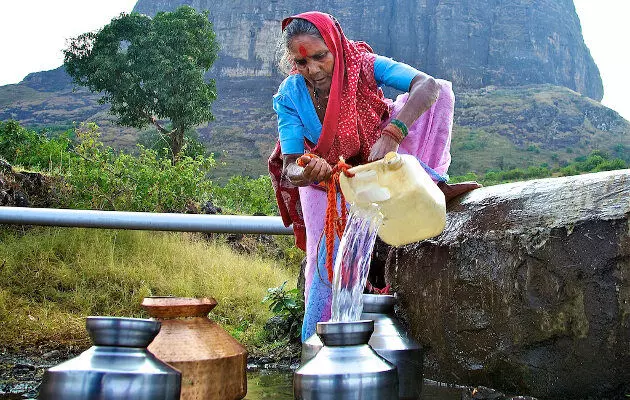What Villages Ignore: Water, Sanitation, Streetlights

A woman next to a well collecting water the old-fashioned way in Methgharkila village near Nashik, Maharashtra. Image: Flickr/Michael Foley
- Panchayats (village councils) spend most of their money on roads and bridges (38%), followed by maintenance of panchayat buildings (26%).
- Not enough is being spent on water supply, sanitation and streetlights.
- Tripura has the highest per capita panchayat expenditure, followed by Telangana and Manipur.
Local governments spend most of their money on the upkeep of roads and bridges, water supply, buildings and community assets, street lighting, sanitation, water drainage and solid-waste management, but a breakup reveals spending imbalances.
Every panchayat spent Rs 189 per capita on an average—between 2007-08 and 2012-13—on roads and Rs 130 per capita on community assets, according to our analysis of panchayat budgets. This is likely to increase.
Little money is being spent on water supply (Rs 73), sanitation (Rs 24) and other services like streetlights (Rs 10), according to the study.
Total expenditure has increased 104%, from Rs 309 per capita in 2007-08 to Rs 631 per capita in 2012-13.
As we previously reported, money allotted to villages for self-governance is set to triple over the next five years, according to a study by Accountability Initiative, a New Delhi-based think tank.
Tripura leads the way in rural spending
The top five states with the highest financial decentralisation in India are Kerala, Karnataka, Maharashtra, Tamil Nadu and Chhattisgarh, according to a study by the Ministry of Panchayati Raj on devolution to local bodies in villages.
However, the panchayats in these states are not among the top spenders.
The highest-spending rural bodies are in Tripura. Its per capita spending is almost double that of states with more money and financial powers.
Tripura has increased its tax collection by 34.48% between 2007-08 and 2011-12. Tripura ranks 22nd in the country with a population of 3.6 million and has a rural population of 2.7 million.
Tripura tops the list due to low population and the increase in tax revenues of panchayats.
The spending patterns are based on the study of panchayat budgets before the recommendations of the 14th Finance Commission were put in place.
What the 14th Finance Commission recommended
The 14th Finance Commission has awarded Rs 200,292.2 crore to panchayats for 2015-2020, which is more than three times the grant of the 13th Finance Commission.
While the 13th Commission grant was for all three tiers of panchayats; district, block and gram panchayat, the 14th Commission grant is only for gram panchayats.
Gram panchayats will now get Rs. 2,404 per capita over five years and Rs 0.17 crore per year (Rs 0.85 crore for five years).
The grant is for basic services, such as sanitation, drinking water and maintenance of community assets. Panchayats must ensure basic services reach everyone, including the most marginalised sections of society, the Commission said.
The panchayats, according to the 14th Finance Commission, will receive the two types of grants from states: basic grants and performance grants.
Performance grants are for panchayats that submit audited annual accounts and increase revenues over the preceding year.
Money allocated for rural India has increased, but the Accountability Initiative study has indicated that data on expenditure of panchayats is not adequate and inconsistent.
Better training for Panchayat functionaries would ensure better audits and more transparency. ■
(You can read the first part—Money For Rural India From Delhi Triples—of this two-part series here.)
(Salve and Tewari are policy analysts at IndiaSpend.)“Liked this story? Indiaspend.com is a non-profit, and we depend on readers like you to drive our public-interest journalism efforts. Donate Rs 500; Rs 1,000, Rs 2,000.”


